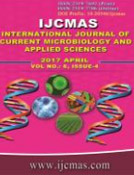


 National Academy of Agricultural Sciences (NAAS)
National Academy of Agricultural Sciences (NAAS)

|
PRINT ISSN : 2319-7692
Online ISSN : 2319-7706 Issues : 12 per year Publisher : Excellent Publishers Email : editorijcmas@gmail.com / submit@ijcmas.com Editor-in-chief: Dr.M.Prakash Index Copernicus ICV 2018: 95.39 NAAS RATING 2020: 5.38 |
Comparison between aquaponics, hydroponics and traditional method for cultivation of spinach was carried out. In this study, spinach was grown in the soilless media like perlite and sphagnum moss. Medias were used to support plant growth. From these Media the perlite media was used in aquaponics and sphagnum moss was used in hydroponics. This study was carried out to examine different morphological characters like height, germination period, surface area, yield of spinach, and biochemical analysis like protein, carbohydrate, chlorophyll content. The height and surface area of the traditionally cultivated spinach (Height- 23 cm) (Surface area- 79 sq.cm) was more than the hydroponically (Height- 18 cm) (Surface area- 70 sq.cm) and aquaponically (Height- 20.5) (Surface area- 72 sq.cm) cultivated spinach. But the germination period of aquaponically and hydroponically cultivated spinach (4th day) was earlier than traditionally cultivated spinach (5th day). The protein and carbohydrate content was more in aquaponically (Protein – 2.9%), (Carbohydrate – 3.9) and hydroponically (Protein - 2.7%), (Carbohydrate – 3.8) cultivated spinach than traditionally (Protein– 2.6%), (Carbohydrate– 3.8) cultivated spinach. Chlorophyll content was highest (0.07%) in the traditionally grown spinach and (0.06%) in aquaponically as well as hydroponically grown spinach. In traditionally and hydroponically cultivated spinach, plants were provided with all the nutritional requirements externally but in aquaponics nutrients were provided naturally through fish excrete. In hydroponics nutrient requirement was less compared to traditional method. In this work, guppy fishes were used in aquaponics as a source of nutrients. For hydroponics, the N: P: K fertilizer named 19:19:19 was given in small quantities. For traditionally cultivated spinach the fertilizers like Urea, 19:19:19 and 15:15:15 were applied. The yield of the aquaponically cultivated spinach was measured (4455Kg/acre); it was slightly more than hydroponically cultivated spinach (3780 Kg/acre) and much more than the traditionally cultivated spinach (1615 Kg/acre).
 |
 |
 |
 |
 |